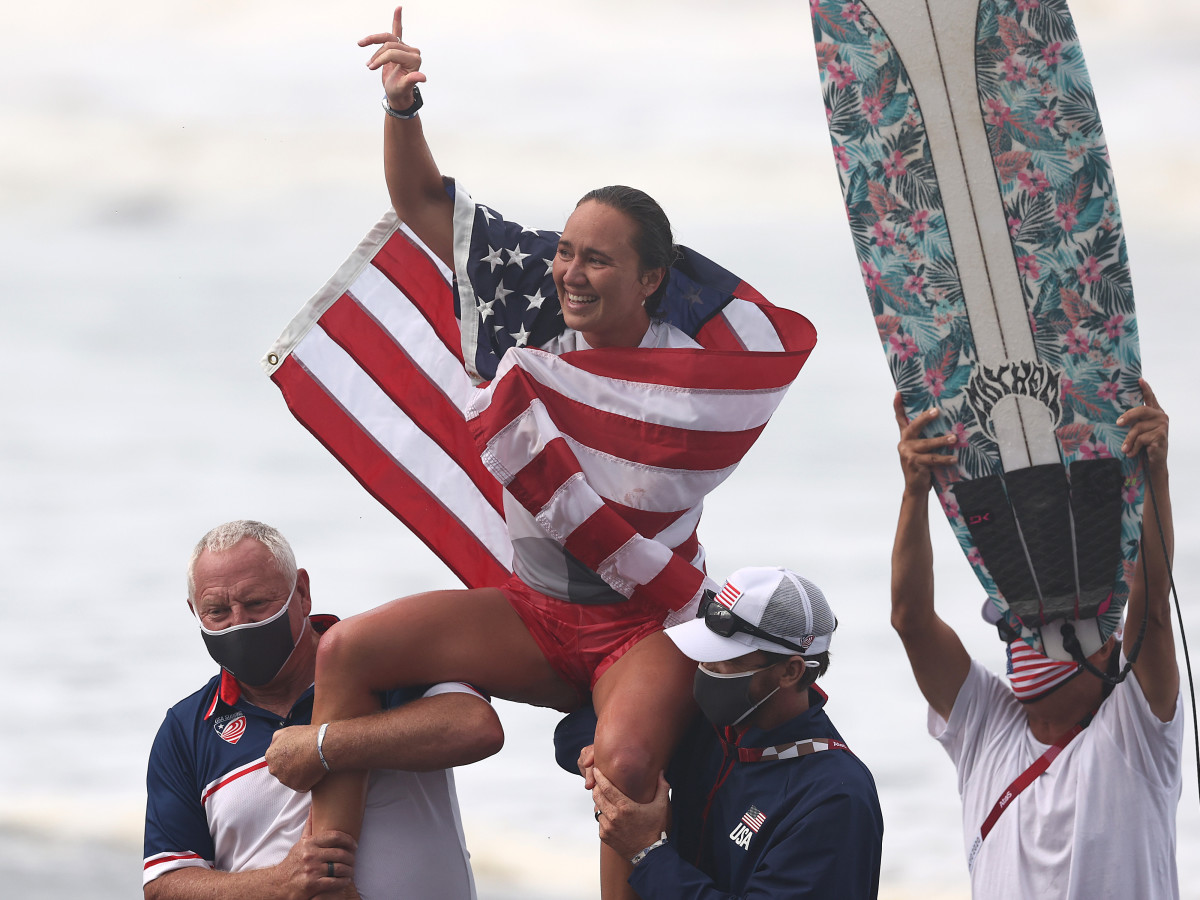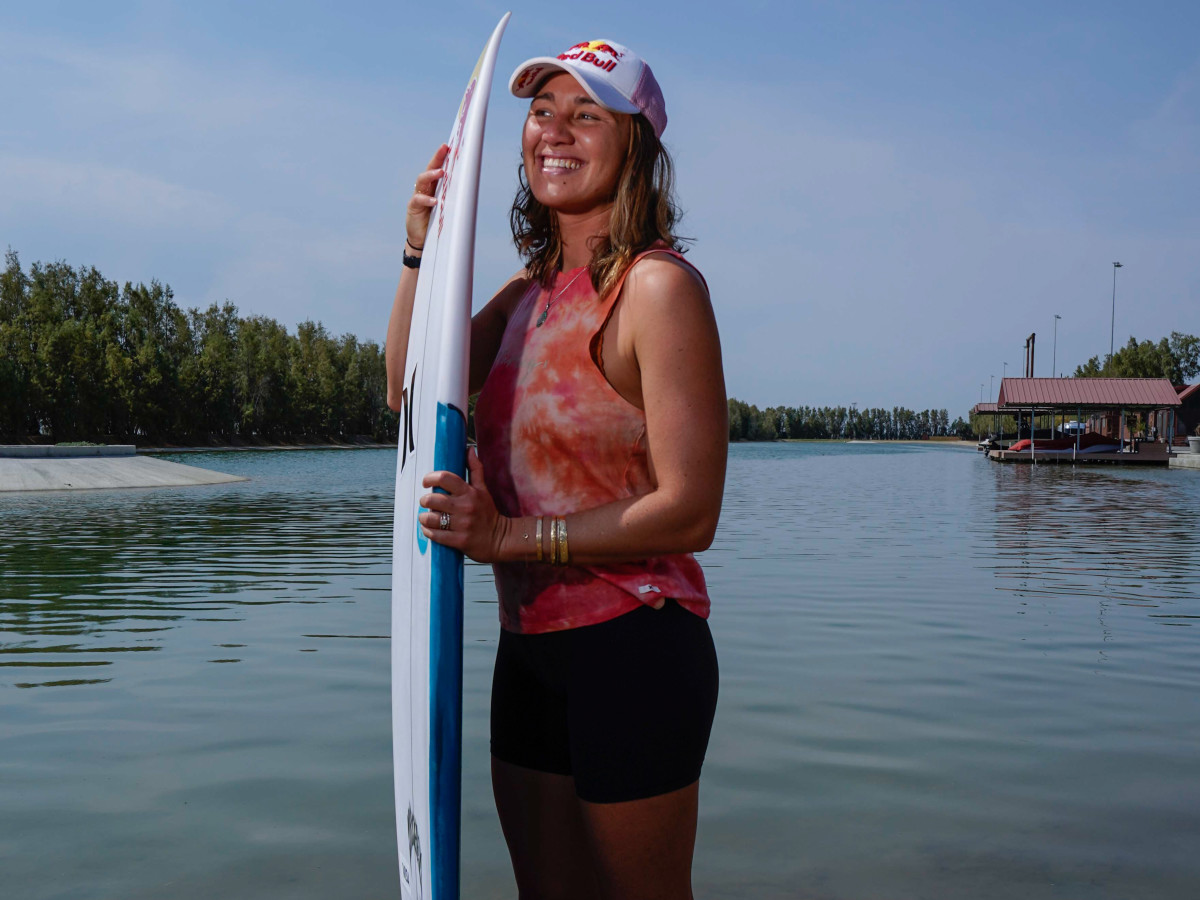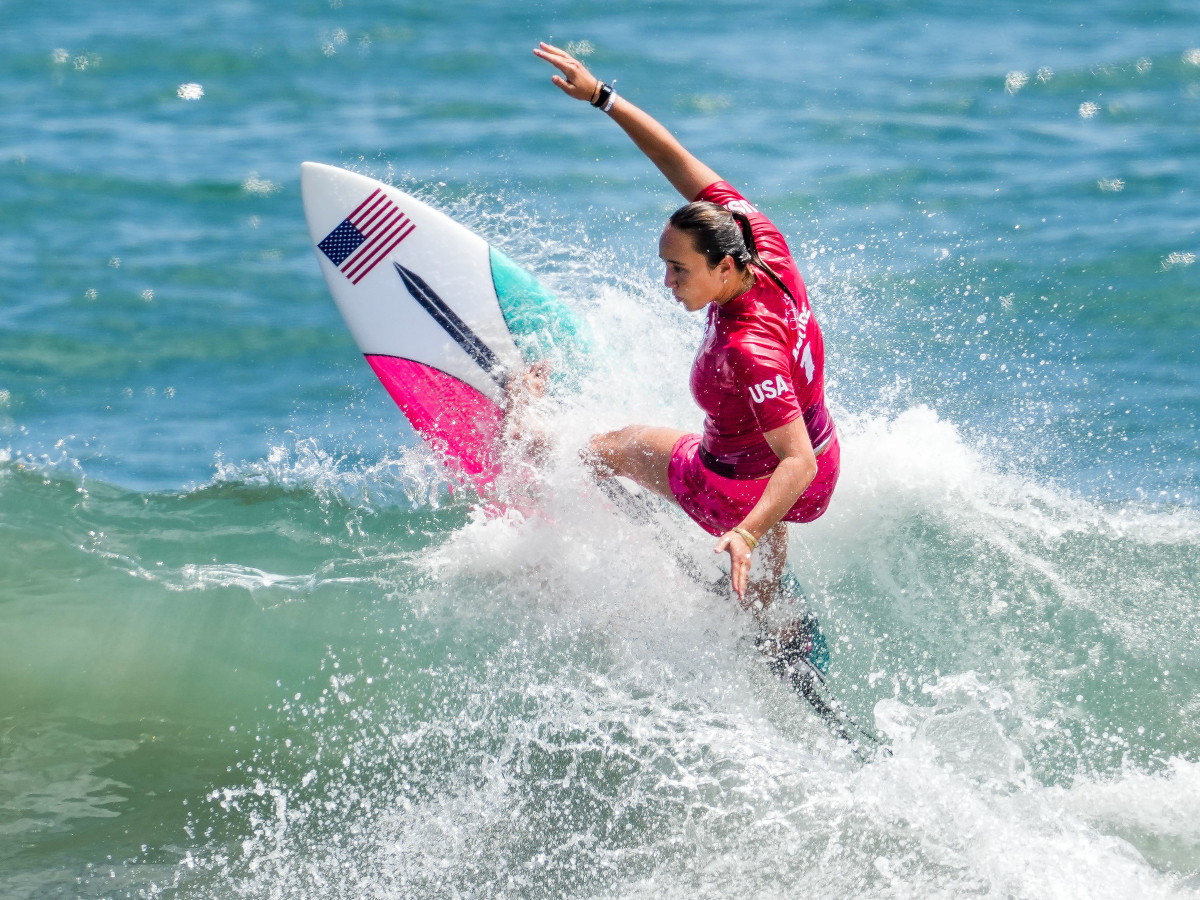Surfing's Spirit, Hawaiian History Embodied in Sport's First Olympic Gold Medalist

TOKYO – The rainbow appeared suddenly, parting dark gray skies that loomed over a surfing venue as a tropical storm descended, as if the rainbow wanted to peek in. Down below, Carissa Moore was surfing. She would soon trudge out of the water and into the waiting arms of her coaches, who lifted her off the sand and carried her off the beach. An American flag hung from her shoulders like a superhero cape.
Across the Pacific Ocean, her relatives clustered around televisions. Well, except for her husband, Luke Untermann, a spouse so unnerved by the history at hand that he had locked himself inside a car, inside a garage, and watched an Olympic final on his cell phone. His screams echoed down the block.
He wasn’t alone. A college professor who has spent a lifetime trying to understand colonialism in his state’s history through the vantage point of Hawaiian surfers saw the rainbow on TV. His five children would soon dance and holler in their living room. But he stopped, stuck, transfixed by the significance.
Isaiah Walker considers himself a historian, not an activist, and in his culture, the one that shapes him, they believe that nature can manifest via their ancestors. There’s a word for that in his native language—Hōʻailona, which signifies someone is being watched over by their kupuna (ancestors), or perhaps another figure from the past. As Walker followed Moore, he could not help but draw out the connections. “I really felt that it had something to do with Duke,” he said.
“Duke” would be Duke Kahanamoku, a swimmer born toward the end of the 19th century, just before the Kingdom of Hawaii was overthrown in 1893. Duke seized a gold and silver medal at the 1912 Olympics, then competed in four more Games, collecting five medals overall. He also traveled the world, giving surfing exhibitions, transforming a sport developed by his ancestors, one laden with deep, spiritual meaning. While Duke popularized surfing on an international stage, he also argued for the sport’s inclusion in the Olympics.
In 2021, surfing made that exact debut, just like Duke had desired, only a century too late. It felt spiritual. Here was this surfer, born and raised on Oahu; this historian, who studies people like her; and this rainbow that reminded both of a man so legendary a statue of him stands guard at Waikiki Beach. Walker could not shake what viewers did not notice, the history that began almost 1,000 years earlier on the islands, how women once dominated surfing on those beaches. How rare, how cosmic, for a rainbow to peek in on a Native Hawaiian, on this very beach, across her home ocean, on the very afternoon she won the first gold medal in the history of Olympic surfing.

Because this is 2021, that sentiment did not reach Moore for almost 30 hours. But on a Zoom call with Sports Illustrated, with both parties in the same building, separated by maybe a quarter mile and a long escalator ride, she paused and leaned forward on the screen. Her voice caught. Tears welled. Because of Duke, her sport and her people, not to mention the thousands of little girls on the islands who could watch her and see themselves.
“I believe in the universe,” she said.
Pro surfing boomed in the 1960s, half a century after Duke’s calls for inclusion and half a century before Olympic organizers came to align with the vision he laid out. Growth led to commercialization, to Quiksilver and Billabong and a $10 billion industry that diverged from Hawaiian roots.
As the historic Games approached and two Hawaiians—Moore and male competitor John John Florence—qualified for Tokyo, their home state applied for recognition. The International Olympic Committee had previously distinguished U.S. territories like Guam, Puerto Rico and American Samoa. Surfing’s international community already viewed Hawaii as an independent entity. Moore and Florence, while both careful to clarify they’re pro-home rather than anti-country, competed not under the U.S. flag but the state one. No one involved sought division. Instead, the advocates wanted to remind the world of who they were, where these surfers—and their sport—had come from. But while folks like Walker sought to reclaim the waves, the IOC ignored their claim, meaning both Hawaiians—one with Native roots, the other born and raised there—would be forced to surf under the U.S. flag.
Neither of the competitors complained. But they understood what the historians and surfing officials in their state were arguing. They all lived in a place that had been colonized, and they believed the ocean was a sort of sanctuary, with autonomy and history and an important preservation of cultural identity at stake.
That very culture all but required they draw connections between the past and present, a notion that gained even more importance as decades flew by and many Native Hawaiians insisted they could see their culture slipping away. They believe that started in the 1890s, when Americans deposed their queen and annexed the islands. Some still consider the U.S. a non-legitimate occupier, the sentiment driven home by families that hang the state flag upside down. Most see surfing as the strongest way to bond their life before and after colonization, to protect what it means to be Hawaiian, in spirit, in the soul.
Moore passed Duke’s statue almost daily growing up as she walked into the ocean and paddled out into the waves. Duke remained celebrated, despite the time that had passed. But while he died before Moore was born, both identified with the same markers, with the spirituality inherent in their sport. Moore would say she had to find her place in the sea before she could ride the waves it birthed. “We believe the ocean and the waves select a person,” Walker says. “Surfing enables us to connect with that identity in the present. It’s that vehicle for us to feel empowered.” By Moore merely participating in the Olympics, she handed the historians, if not exactly what they wanted, then at least a larger megaphone. That the Games themselves often took place at the intersection of sport and politics helped them tell their story.
The question lingered: what, exactly, would that look like?

Moore, 28, became a surfer early on, under the guidance of her father, Chris. She won 11 national titles as an amateur and turned pro in 2010. The ocean called to her, and she called back, as if to say, I’m here, finishing third in the world in her rookie season and becoming the youngest world champion in the history of her sport.
She soon emerged as a legitimate competitor to the queen of international surfing, Stephanie Gilmore, an Australian, wave-mastering goddess. Their seemingly respectful rivalry came to define an era for the sport. From ’10 to ’15, they passed titles back and forth like a hot potato, with Moore eventually winning four to Gilmore’s seven.
Like former President Barack Obama, Moore graduated from Punahou High School, which is where she met her husband and studied Japanese. Like the historian who sought recognition, she deployed her growing platform for good causes, donating some of her winnings to local surf clubs and speaking out against sexism, binge eating and body shaming, while taking up for the environment. Officials in Honolulu named a day after her—Jan. 4. She was inducted into the Surfing Hall of Fame and credited with speeding up a revolution.
The slump came next, at least relative to the impossible standards she had created for herself. In ’17, Moore won only once. She fell to fifth in the world rankings. That set the stage for her comeback, the one that led to the fourth title in ’19, a No. 1 overall ranking, and ultimately, the Olympic competition, which took place at Tsurigasaki Surfing Beach in Chiba prefecture.
There, she would confront more than competitors, linking the history of her sport in her state to the nation across the ocean. She would remind the world that women dominated that sport, for decades, that Hawaiians dominated, that the ancient past wasn’t all that different from the here-and-now. She could simultaneously create a new era, while taking a sport—and the world—on a trip back to its origins.
“All” she needed to do was show up in Japan and win.
The host country boasted of its own long and celebrated surfing history, holding its first contest in Kamogawa in 1965. It wasn’t uncommon for the office dwellers to clock out, hop on the train and head straight to one beach or another, swapping actual suits for the wet version in the parking lots.
As if the historical significance did not complicate the backdrop enough already, the Olympic surfers were greeted by Tropical Storm Nepartak. High winds whipped through the venue, shaking the makeshift roof of the media center, leading to fickle waves. “Just imagine looking out at the ocean,” Moore said, “and it looks like a total mess.”
Eight days had been built into the schedule, in order to account for changing conditions and keep the athletes safe. But rather than stretch out the competition, officials decided Tuesday to condense it. They held the quarterfinals, the semis and the medal matches without pause, squeezing 24 scheduled hours into 12 jam-packed ones to try and beat the storm.
The surfers competed head-to-head in elimination rounds, which American competitor Kolohe Andino described as “wild and wooly” in a text message. Sometimes, the waves resembled ankle breakers; other times, they crested over heads. This being surfing, the athletes were not thrown off by shifting conditions, choppy water or shapeless waves. But because this is surfing, more than fitness and skill came into play. Fortune also became significant, because timing mattered, because even the most elite surfers in the world could not summon the right breaks on command.
At least on Tuesday, the waves were bigger, which Moore preferred. Gilmore, a chief competitor, had already been eliminated. So had Yolanda Hopkins of Portugal, ranked second in the world.
The coach for the Americans, former U.S. Open champ Brett Simpson, surveyed the action from the beach, watching as Moore “started to find her groove.” She topped Sofia Mulanovich of Peru in the quarters, bested Amuro Tsuzuki of Japan in the semifinals and triumphed over Bianca Buitendag of South Africa in the medal round. The final competitors on the women’s side met in shallow water and shared a hug tinged by history.
Moore had won three times in roughly six hours, twice easily, with her closest competition taking place against Tsuzuki. Simpson attributed the conquered gauntlet to her mindset, believing that Moore had “surfed free,” despite the weight she carried.
She jogged onto the beach and hugged her coach. Simpson told her that he loved her and asked how the moment felt. Moore shrugged. She had not even begun to process what it meant, for herself, her country and her state. She blew kisses to the grandstand, wiped tears of joy from her cheeks and celebrated with her teenaged teammate, Caroline Marks, who finished fourth.

What it meant—and what it could mean—started to be revealed. But not fully, not yet.
For Moore, the reaction, thousands of messages and phone calls and social media comments, threatened to overwhelm her. She promised to respond to everyone as soon as possible, and she thought about the foundation she had created, Moore Aloha, and how many additional female surfers she could reach.
For Simpson, her coach, the victory represented a watershed moment for their sport. He had grown up in California, the son of an NFL defensive back, Bill, who played for the Rams and the Bills from 1974 to ’82. When he became a surfer, Brett says, his father “was kind of tripping on me” for participating in a sport that was widely accepted but not exactly mainstream. The event in Tokyo, had a different feel, a level of importance, jolted by the adrenaline of this being the first time. “It’s going to help humongously in general,” he said, noting that his father had morphed into a superfan of sorts.
For Fernando Aguerre, president of the International Surfing Association, a man who wore yellow pants, a shirt with flower patterns and a straw hat to the medal ceremony, the event meant growth. He labeled the final competition slate “the most beautiful day in surfing history.” He had named his son after Duke and had listened to the historians, telling them he hoped Hawaii’s influence would be celebrated at the Olympics. Because of Moore, it most definitely was.
For Walker, the historiographer, Moore and her gold would generate more unity than division. His 7-year-old daughter, Makamae, is already surfing obsessed, already wants to turn pro. One niece, Hokulani, has trained under Moore and coaches who benefit from her foundation’s grants. After Tuesday, how many more young women will do the same?
“I’ve always believed that surfing would be a vehicle to draw attention to our history, so that the world can understand how complicated it is,” he said. If Moore could not listen to Hawaii’s anthem play atop the medal stand, if she could not wear her state’s flag to television appearances, she presented something better, more impactful, to the world: a living embodiment of that spirit. (Some of the islanders photoshopped their flags over the American one, anyway.)
In fact, both Simpson and Walker use the same lofty phrase to describe their champion. She is, both say, a female, modern-day version of Duke; like him, a genuine soul who projects the aloha spirit. Told of that sentiment, Moore blushed, then stammered, eventually adding that she could not accept it but was honored, nonetheless.
On Wednesday, she made her way to Tokyo, to take part in a series of interviews. She had already celebrated with her teammates, as Marks gave her a champagne shower, and they downed a “couple” shots of whiskey “and passed out.” She encouraged young surfers in Hawaii to dream bigger, staying away from the politics, staying with the potential impact. She tucked a fake plumeria flower behind her left ear and draped the first gold medal in her sport’s history around her neck.
Soon enough, she will return home to a hero’s welcome. Her mother wanted to organize a crowd to greet her at the airport. But Moore remained low-key, making sure to express pride in her country and her state, the gap between them now closed a little by her Olympic efforts.
More Olympic Coverage:
